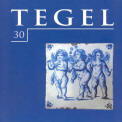 bevat artikelen over de volgende onderwerpen:
bevat artikelen over de volgende onderwerpen:
Vroege ornamenttegels in het verre Einbeck
Andreas Heege - page 4
In recent years interesting finds have been made by the archeological department in the town centre of Einbeck, about halfway between Hanover and Kassel, in Germany. Most of the material can be dated to the end of the 16th or the beginning of the 17th century. The material was excavated on the premises that from 1592 till at least 1616 belonged to the goldsmith and town treasurer Andreas Einbeck. The finds include nine fragments of at least four majolica tiles, which were produced in Antwerp, Middelburg, Haarlem or Amsterdam between c. 1570 and 1600. How such early Netherlandish tiles found their way so far into Germany is unknown. We do know, however, that beer was exported in large quantities from Einbeck to the Netherlands. Possibly the tiles were taken to Einbeck on the return journy by waterway or by road.
De Pannenkoekenbakster
Lida Brouwer - Brand - page 8
Two tiles representing women who are frying pancakes are discussed in this article. The author has done research into the pictorial models for these tile depictions. The theme was popular with many artists in the Golden Age. In 1635 Rembrandt made the etching in illustration 2.
The image of the pancake maker also has a symbolic meaning, though not a particularly favourable one. The term ‘pancake maker’ has the following connotations: bungler, botcher, blunderer, someone who does not know his trade, unmanly person and, in particular, incompetent sailor.
Twee heiligen en twee 'Paapse duiveljagers'
Arend Jan Gierveld - page 11
The author has acquired a number of remarkable tiles from a small collection left by a neighbour. This person had always had an eye for unusual images. For example, he had purchased a tile depicting St Agnes, with her attribute a lamb with a halo (ill. 1). Another exceptional tile represents St Antony Abbot, identifiable from the pig, the bell and the tau cross on his chest. His staff, however, is surmounted by a papal cross with four transoms, instead of the usual three (ill. 2). The author has traced the print that this latter tile was modelled on (ill. 3).
But even more remarkable is the description of two tiles (ills. 4, 5) as satirical representations of regular clergy performing exorcism. Never before has such an interpretation been proposed for this type of tile. As late as the beginning of the 17th century exorcism was used by zealous priests, especially Jesuits and, to a lesser extent, Franciscans as a method of reclaiming lost souls.
Een Harlinger 17de-eeuwse amorpilaster
Dirk J. Hoekstra - page 15
Tile pilasters from the 17th century are rare compared with 18th century examples. Tegel 16, 24, 26, 28 highlighted early 17th century tile pilasters and tile pictures on rear walls of fireplaces made in Rotterdam. These pilasters are two-dimensional tile interpretations of sandstone supporting columns. Clearly, such tile imitations function not as structural supports, but as ornamentation around the fireplace. Some 17th century tile pilasters would have been produced outside Rotterdam. This appears to be the case with an incomplete cupid pilaster dating from 1670-1690 which was purchased in the province of Friesland. The sponsen used for this pilaster, which was discovered in 1995, have been found in the collection of the Fries Museum in Leeuwarden. Sponsen 1-3, for the base, are missing. The rest (sponsen 4-13) for the body of the pilaster and the capital are complete (ill. 10). The cupids depicted on the pilaster are identical to those on another group of tiles, each of which has three cupids (ills. 1-8, 11).
The 17th century sponsen of the cupid pilaster in the Fries Museum collection are nearly all from Pyter Grauda’s tile factory in Harlingen. They bear the initials P.G. or, occasionally, the full name (ill. 15). It seems reasonable to conclude, therefore, that the cupid pilaster was painted in Harlingen, and possibly in the Grauda factory itself.
De Hollandse tegelbakkers in 1753
Johan A. Kamermans - page 20
Towards the end of December 1752, the tile makers in the province of Holland submitted a petition to the States of Holland (the provincial assembly) calling for the imposition of heavy taxes on tiles imported from the other provinces. The United Dutch Republic consisted of autonomous provinces which regarded one another from an economic point of view as ‘foreign’, and levied import duties on one another’s products. The tile makers’ petition and the debates and decrees it led to show that competition from the provinces of Friesland and Utrecht did not begin to have an impact until the middle of the eighteenth century.
"Jozef verklaart dromen in de gevangenis"
Robert Nouwen - page 25
At Bokrijk Open Air Museum in Belgium an ensemble of tin-glaze tiles from a farmstead at 56, Dorpsstraat, Elversele, has been reassembled in a house from Lokeren (1751).
The tiles were originally supplied by a Rotterdam workshop and date from about 1700. The combination of tiles is interesting: there are two tile pictures representing The Marriage at Cana and The Adoration of the Shepherds, and surrounding them are single Bible tiles depicting various scenes. One of these single tiles is Joseph interprets Dreams in Prison (Genesis 40:5-8).
Illustration 4 is a hitherto unknown variant of this familiar scene (ill. 3) with the three shackled men. In illustration 4 two of the men are seated on the floor, with the third standing between them; he can thus be identified as Joseph. His posture, turning towards the man on his right, indicates that he is interpreting the dream of the latter. Tiles B.68.209-2 and B.68.209-3 depict the same scene with minor variations.
Documentation of tile ensembles within one specific context is important primarily because it makes it possible to determine how large a series is. Furthermore the Elversele ensemble shows that not all scenes are known and recorded. The occurrence of the standing Joseph on a set of three tiles with minor differences is what makes them significant. This implies that in the future new finds may well lead to further scenes being added to the inventory so conscientiously carried out by J. Pluis.
Brugse tegels
Piet Swimberghe - page 28
Recent archeological and archival research proves that tin-glaze wall tiles, based on examples from the northern part of the Low Countries, were produced in Flanders as early as the 17th and 18th centuries. A large part of the collection of patterns has been discovered belonging to a works in Bruges, which was established by the sculptor Hendrik Pulinx and was productive in the latter half of the 18th century. Besides classical designs with shepherds, particularly noteworthy are the marbled tiles and so-called pear tiles. On the whole inferior in quality to their northern exemplars, the Bruges tiles also differ from them in colour and format.
De betegeling van het pand Havenstraat 2 te Erica
Jan Pluis - page 33
A large company director’s residence, dating from 1897 in the village of Erica in the Dutch eastern province of Drente, was threatened with demolition. A variety of characteristic and unique tile decorations from the art nouveau period can be found on the inside as well as the outside of the property. A campaign of information and persuasion eventually succeeded in saving the house for posterity. The arguments in favour of preservation are set out in this article.
De Hoffman-ringoven afgebeeld op een tegel
F.H. Landzaat - page 35
The collection of the Dutch Tile Museum at Otterlo includes a block of four blue tiles with landscapes in a double circle, produced in Utrecht. One of the tiles depicts a Hoffmann round kiln. This brick kiln was designed by the German Friedrich Eduard Hoffmann and the first one was built in Germany in 1859.
The round kiln was first used in the Netherlands in 1868. This type of kiln became very popular. The tiles date from the latter half of the 19th century. It is rare for a building on a landscape tile to be so easily identified.
Zodiak en seizoenen: de voortgang van de tijd\
Hansa Krijgsman, research Frits Stuurman - page 37
There is a lovely series of tile pictures to be found on an apartment building on Nieuwe Binnenweg, Rotterdam of 1937, depicting the four seasons and the twelve signs of the zodiac. The artist was A.M. van der Plas, who also designed other tile pictures on buildings elsewhere in the city.
The zodiac has traditionally been used to represent the progress of time, and around the same period it also turned up in architectural ornaments by other Dutch artists like Derkinderen and Kropholler. This may be connected with the contemporaneous appearance of horoscopes in the popular press. Russel-Tiglia, the tile works that produced Van der Plas’s pictures, also made a series of separate tiles on the basis of the same designs, each showing one sign of the zodiac.
Een 'Indisch' tableau van P.B. Delft in het Tropenmuseum
Lejo Schenk - page 40
The collection of the Koninklijk Instituut van de Tropen (Royal Institute for the Tropics) in Amsterdam includes a tile picture made by the Delft Pottery in Hilversum. The picture is on show this autumn at the exhibition The Dutch Encounter with South East Asia 1600-1900 at the Rijksmuseum, in Amsterdam.
It shows a photographic representation of the port of Sabang on the north coast of Sumatra. The Dutch built the harbour round 1900 for military and transport purposes, in particular to compete with the British ports of Penang and Singapore. One of the people responsible for this project was the chief administrator, L.L.F. de Greve, who was presented with the picture on vacating his post in 1916.
The painter of the tile picture has not been identified; further research on the Delft Pottery painters is still required, even after Mrs Singelenberg-van der Meer’s publication (1983). It is clear, however, that the painter was thoroughly familiar with the iconography of the Dutch East Indies. The highly decorated border surrounding the picture contains a wealth of symbolic motifs from Indo-Javanese culture, with its prehistoric, Buddhist, Hindu and Islamic roots. At the beginning of the twentieth century this culture was the focus of great interest in the Netherlands, which still prided itself on its colonial possesions.
Bibliography 2001-2002
page 46





